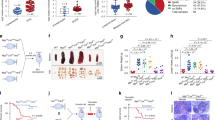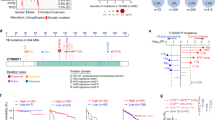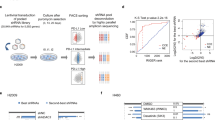Abstract
The mechanisms of cell transformation mediated by the highly oncogenic, chimeric NPM/ALK tyrosine kinase remain only partially understood. Here we report that cell lines and native tissues derived from the NPM/ALK-expressing T-cell lymphoma (ALK+ TCL) display phosphorylation of the extracellular signal-regulated protein kinase (ERK) 1/2 complex. Transfection of BaF3 cells with NPM/ALK induces phosphorylation of EKR1/2 and of its direct activator mitogen-induced extracellular kinase (MEK) 1/2. Depletion of NPM/ALK by small interfering RNA (siRNA) or its inhibition by WHI-154 abrogates the MEK1/2 and ERK1/2 phosphorylation. The NPM/ALK-induced MEK/ERK activation is independent of c-Raf as evidenced by the lack of MEK1/2 and ERK1/2 phosphorylation upon c-Raf inactivation by two different inhibitors, RI and ZM336372, and by its siRNA-mediated depletion. In contrast, ERK1/2 activation is strictly MEK1/2 dependent as shown by suppression of the ERK1/2 phosphorylation by the MEK1/2 inhibitor U0126. The U0126-mediated inhibition of ERK1/2 activation impaired proliferation and viability of the ALK+ TCL cells and expression of antiapoptotic factor Bcl-xL and cell cycle-promoting CDK4 and phospho-RB. Finally, siRNA-mediated depletion of both ERK1 and ERK2 inhibited cell proliferation, whereas depletion of ERK 1 (but not ERK2) markedly increased cell apoptosis. These findings identify MEK/ERK as a new signaling pathway activated by NPM/ALK and indicate that the pathway represents a novel therapeutic target in the ALK-induced malignancies.
This is a preview of subscription content, access via your institution
Access options
Subscribe to this journal
Receive 50 print issues and online access
$259.00 per year
only $5.18 per issue
Buy this article
- Purchase on Springer Link
- Instant access to full article PDF
Prices may be subject to local taxes which are calculated during checkout






Similar content being viewed by others
References
Bischof D, Pulford K, Mason DY, Morris SW . (1997). Role of the nucleophosmin (NPM) portion of the non-Hodgkin's lymphoma-associated NPM-anaplastic lymphoma kinase fusion protein in oncogenesis. Mol Cell Biol 17: 2312–2325.
Chiarle R, Gong JZ, Guasparri I, Pesci A, Cai J, Liu J et al. (2003). NPM-ALK transgenic mice spontaneously develop T-cell lymphomas and plasma cell tumors. Blood 101: 1919–1927.
Chiarle R, Simmons WJ, Cai H, Dhall G, Zamo A, Raz R et al. (2005). Stat3 is required for ALK-mediated lymphomagenesis and provides a possible therapeutic target. Nat Med 11: 623–629.
Crockett DK, Lin Z, Elenitoba-Johnson KS, Lim MS . (2004). Identification of NPM–ALK interacting proteins by tandem mass spectrometry. Oncogene 23: 2617–2629.
Epling-Burnette PK, Bai F, Wei S, Chaurasia P, Painter JS, Olashaw N et al. (2004). ERK couples chronic survival of NK cells to constitutively activated Ras in lymphoproliferative disease of granular lymphocytes (LDGL). Oncogene 23: 9220–9229.
Fujimoto J, Shiota M, Iwahara T, Seki N, Satoh H, Mori S et al. (1996). Characterization of the transforming activity of p80, a hyperphosphorylated protein in a Ki-1 lymphoma cell line with chromosomal translocation t(2;5). Proc Natl Acad Sci USA 93: 4181–4186.
Hallek M, Bergsagel PL, Anderson KC . (1998). Multiple myeloma: increasing evidence for a multistep transformation process. Blood 91: 3–21.
Hanahan D, Weinberg RA . (2000). The hallmarks of cancer. Cell 100: 57–70.
Hoshino R, Chatani Y, Yamori T, Tsuruo T, Oka H, Yoshida O et al. (1999). Constitutive activation of the 41-/43-kDa mitogen-activated protein kinase signaling pathway in human tumors. Oncogene 18: 813–822.
Hoyle PE, Moye PW, Steelman LS, Blalock WL, Franklin RA, Pearce M et al. (2000). Differential abilities of the Raf family of protein kinases to abrogate cytokine dependency and prevent apoptosis in murine hematopoietic cells by a MEK1-dependent mechanism. Leukemia 14: 642–656.
Kim SC, Hahn JS, Min YH, Yoo NC, Ko YW, Lee WJ . (1999). Constitutive activation of extracellular signal-regulated kinase in human acute leukemias: combined role of activation of MEK, hyperexpression of extracellular signal-regulated kinase, and downregulation of a phosphatase, PAC1. Blood 93: 3893–3899.
Kuefer MU, Look AT, Pulford K, Behm FG, Pattengale PK, Mason DY et al. (1997). Retrovirus-mediated gene transfer of NPM-ALK causes lymphoid malignancy in mice. Blood 90: 2901–2910.
Marzec M, Kasprzycka M, Ptasznik A, Wlodarski P, Zhang Q, Odum N et al. (2005). Inhibition of ALK enzymatic activity in T-cell lymphoma cells induces apoptosis and suppresses proliferation and STAT3 phosphorylation independently of Jak3. Lab Invest 85: 1544–1554.
Matsumoto S, Miyagishi M, Akashi H, Nagai R, Taira K . (2005). Analysis of double-stranded RNA-induced apoptosis pathways using interferon-response noninducible small interfering RNA expression vector library. Biol Chem 280: 25687–25696.
Milella M, Kornblau SM, Estrov Z, Carter BZ, Lapillonne H, Harris D et al. (2001). Therapeutic targeting of the MEK/MAPK signal transduction module in acute myeloid leukemia. J Clin Invest 108: 851–859.
Morgan MA, Dolp O, Reuter CW . (2001). Cell-cycle-dependent activation of mitogen-activated protein kinase kinase (MEK-1/2) in myeloid leukemia cell lines and induction of growth inhibition and apoptosis by inhibitors of RAS signaling. Blood 97: 1823–1834.
Morris SW, Kirstein MN, Valentine MB, Dittmer KG, Shapiro DN, Saltman DL et al. (1994). Fusion of a kinase gene, ALK, to a nucleolar protein gene, NPM, in non-Hodgkin's lymphoma. Science 263: 1281–1284.
Motegi A, Fujimoto J, Kotani M, Sakuraba H, Yamamoto T . (2004). ALK receptor tyrosine kinase promotes cell growth and neurite outgrowth. J Cell Sci 117: 3319–3329.
Pardo OE, Arcaro A, Salerno G, Raguz S, Downward J, Seckl MJ . (2002). Fibroblast growth factor-2 induces translational regulation of Bcl-XL and Bcl-2 via a MEK-dependent pathway: correlation with resistance to etoposide-induced apoptosis. J Biol Chem 277: 12040–12046.
Platanias LC . (2003). Map kinase signaling pathways and hematologic malignancies. Blood 101: 4667–4679.
Pratt G . (2002). Molecular aspects of multiple myeloma. Mol Pathol 55: 273–283.
Roux PP, Blenis J . (2004). ERK and p38 MAPK-activated protein kinases: a family of protein kinases with diverse biological functions. Microbiol Mol Biol Rev 68: 320–344.
Shiota M, Fujimoto J, Semba T, Satoh H, Yamamoto T, Mori S . (1994). Hyperphosphorylation of a novel 80 kDa protein-tyrosine kinase similar to Ltk in a human Ki-1 lymphoma cell line, AMS3. Oncogene 9: 1567–1574.
Souttou B, Carvalho NB, Raulais D, Vigny M . (2001). Activation of anaplastic lymphoma kinase receptor tyrosine kinase induces neuronal differentiation through the mitogen-activated protein kinase pathway. J Biol Chem 276: 9526–9531.
Tanaka T, Kyrokawa M, Ueki K, Tanaka K, Imai Y, Mitani K et al. (1996). The extracellular signal-regulated kinase pathway phosphorylates AML1, an acute myeloid leukemia gene product, and potentially regulates its transactivation ability. Mol Cell Biol 16: 3967–3979.
Towatari M, Iida H, Tanimoto M, Iwata H, Hamaguchi M, Saito H . (1997). Constitutive activation of mitogen-activated protein kinase pathway in acute leukemia cells. Leukemia 11: 479–484.
Ueda Y, Hirai S, Osada S, Suzuki A, Mizuno K, Ohno S . (1996). Protein kinase C activates the MEK–ERK pathway in a manner independent of Ras and dependent on Raf. J Biol Chem 271: 23512–23519.
Ussar S, Voss T . (2004). MEK1 and MEK2, different regulators of the G1/S transition. J Biol Chem 279: 43861–43869.
Wan W, Albom MS, Lu L, Quail MR, Becknell NC, Weinberg LR et al. (2006). Anaplastic lymphoma kinase activity is essential for the proliferation and survival of anaplastic large-cell lymphoma cells. Blood 107: 1617–1623.
Wang X, Wang Q, Hu W, Evers BM . (2004). Regulation of phorbol ester-mediated TRAF1 induction in human colon cancer cells through a PKC/RAF/ERK/NF-kappaB-dependent pathway. Oncogene 23: 1885–1895.
Wasik MA . (2002). Expression of anaplastic lymphoma kinase in non-Hodgkin's lymphomas and other malignant neoplasms. Biological, diagnostic, and clinical implications. Am J Clin Pathol 118: S81–S92.
Wen-Sheng W . (2006). Protein kinase C alpha trigger Ras and Raf-independent MEK/ERK activation for TPA-induced growth inhibition of human hepatoma cell HepG2. Cancer Lett 239: 27–35.
Wlodarski P, Kasprzycka M, Liu X, Marzec M, Robertson ES, Slupianek A et al. (2005). Activation of mammalian target of rapamycin in transformed B lymphocytes is nutrient dependent but independent of Akt, mitogen-activated protein kinase/extracellular signal-regulated kinase kinase, insulin growth factor-I, and serum. Cancer Res 65: 7800–7808.
Zhang Q, Raghunath PN, Xue L, Majewski M, Carpentieri DF, Odum N et al. (2002). Multilevel dysregulation of STAT3 activation in anaplastic lymphoma kinase-positive T/null-cell lymphoma. J Immunol 168: 466–474.
Acknowledgements
This work was supported in part by grants from the National Cancer Institute – R01-CA89194 and R01-CA96856.
Author information
Authors and Affiliations
Corresponding author
Rights and permissions
About this article
Cite this article
Marzec, M., Kasprzycka, M., Liu, X. et al. Oncogenic tyrosine kinase NPM/ALK induces activation of the MEK/ERK signaling pathway independently of c-Raf. Oncogene 26, 813–821 (2007). https://doi.org/10.1038/sj.onc.1209843
Received:
Revised:
Accepted:
Published:
Issue Date:
DOI: https://doi.org/10.1038/sj.onc.1209843
Keywords
This article is cited by
-
The mechanism of cancer drug addiction in ALK-positive T-Cell lymphoma
Oncogene (2020)
-
Peripheral T cell lymphomas: from the bench to the clinic
Nature Reviews Cancer (2020)
-
Exploring Missense Mutations in Tyrosine Kinases Implicated with Neurodegeneration
Molecular Neurobiology (2017)
-
Activating mutations in ALK kinase domain confer resistance to structurally unrelated ALK inhibitors in NPM-ALK-positive anaplastic large-cell lymphoma
Journal of Cancer Research and Clinical Oncology (2014)
-
Differential expression of aurora-A kinase in T-cell lymphomas
Modern Pathology (2013)



